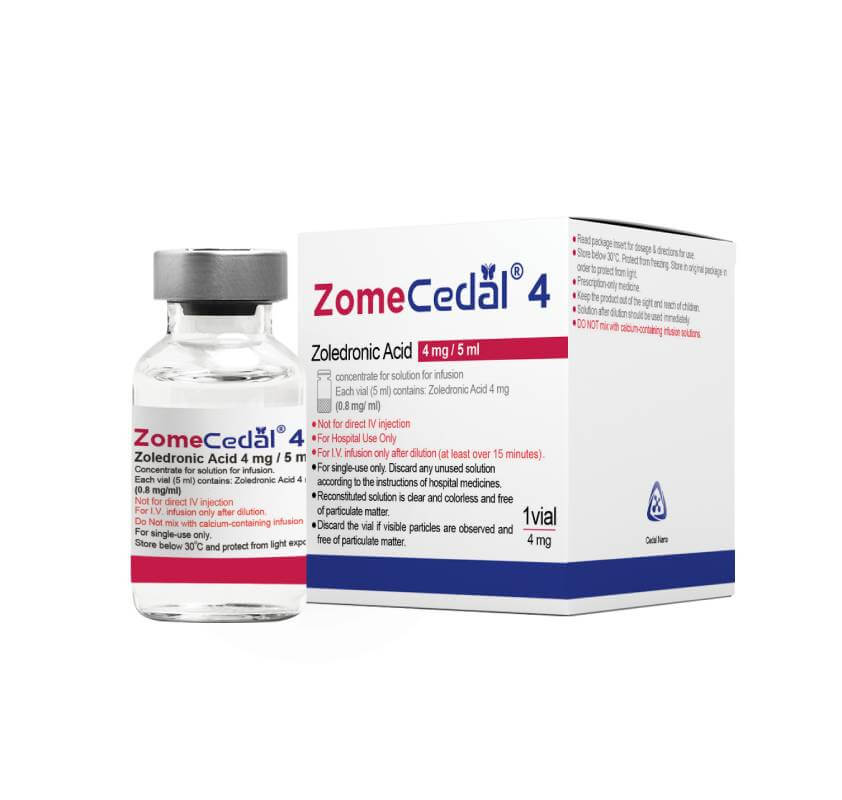Summary of the safety profile
Within three days after zoledronic acid administration, an acute phase reaction has commonly been reported, with symptoms including bone pain, fever, fatigue, arthralgia, myalgia, rigors and arthritis with subsequent joint swelling; these symptoms usually resolve within a few days (see description of selected adverse reactions).
The following are the important identified risks with zoledronic acid in the approved indications: Renal function impairment, osteonecrosis of the jaw, acute phase reaction, hypocalcaemia, atrial fibrillation, anaphylaxis, interstitial lung disease. The frequencies for each of these.
List of adverse reactions
The following adverse reactions, listed below, have been accumulated from clinical studies and post-marketing reports following predominantly chronic treatment with 4 mg zoledronic acid:
Very common (≥ 1/10): Hypophosphataemia|
Common (≥1/100 to <1/10): Anaemia, headache, conjunctivitis, nausea, vomiting, decrease appetite, bone pain, myalgia, arthralgia, generalised pain, renal impairment, fever, flu-like syndrome (including fatigue, rigors, malaise and flushing), blood creatinine and blood urea increased, hypocalcaemia.
uncommon (≥1/1,000 to <1/100): Thrombocytopenia, leukopenia, hypersensitivity reaction, anxiety, sleep disturbance, dizziness, paraesthesia, dysgeusia, hypoaesthesia, hyperaesthesia, tremor, somnolence, blurred vision, scleritis and orbital inflammation, hypertension, hypotension, atrial fibrillation, hypotension leading to syncope or circulatory collapse, dyspnoea, cough, bronchoconstriction, diarrhoea, constipation, abdominal pain, dyspepsia, stomatitis, dry mouth, pruritus, rash (including erythematous and macular rash), increased sweating, muscle cramps, osteonecrosis of the jaw, acute renal failure, haematuria, proteinuria, asthenia, peripheral oedema, injection site reactions (including pain, irritation, swelling, induration), chest pain, weight increase, anaphylactic reaction/shock, urticaria, hypomagnesaemia, hypokalaemia
Rare (≥1/10,000 to <1/1,000): Pancytopenia, angioneurotic oedema, confusion, uveitis, bradycardia, cardiac arrhythmia (secondary to hypocalcaemia), interstitial lung disease, acquired Fanconi syndrome, arthritis and joint swelling as a symptom of acute phase reaction, hyperkalaemia, hypernatraemia
Very rare (<1/10,000): Convulsions, hypoaesthesia and tetany (secondary to hypocalcaemia), episcleritis, osteonecrosis of the external auditory canal (bisphosphonate class adverse reaction) and other anatomical sites including femur and hip,
Description of selected adverse reactions
Renal function impairment
Factors that may increase the potential for deterioration in renal function include dehydration, pre-existing renal impairment, multiple cycles of zoledronic acid or other bisphosphonates, as well as concomitant use of nephrotoxic medicinal products or using a shorter infusion time than currently recommended. Renal deterioration, progression to renal failure and dialysis have been reported in patients after the initial dose or a single dose of 4 mg zoledronic acid.
Osteonecrosis of the jaw
Cases of osteonecrosis of the jaw have been reported, predominantly in cancer patients treated with medicinal products that inhibit bone resorption, such as zoledronic acid. Many of these patients were also receiving chemotherapy and corticosteroids and had signs of local infection including osteomyelitis. The majority of the reports refer to cancer patients following tooth extractions or other dental surgeries.
Atrial fibrillation
In one 3-year, randomised, double-blind controlled trial that evaluated the efficacy and safety of zoledronic acid 5 mg once yearly vs. placebo in the treatment of postmenopausal osteoporosis (PMO), the overall incidence of atrial fibrillation was 2.5% (96 out of 3,862) and 1.9% (75 out of 3,852) in patients receiving zoledronic acid 5 mg and placebo, respectively. The rate of atrial fibrillation serious adverse events was 1.3% (51 out of 3,862) and 0.6% (22 out of 3,852) in patients receiving zoledronic acid 5 mg and placebo, respectively. The imbalance observed in this trial has not been observed in other trials with zoledronic acid, including those with zoledronic acid (zoledronic acid) 4 mg every 3-4 weeks in oncology patients. The mechanism behind the increased incidence of atrial fibrillation in this single clinical trial is unknown.
Acute phase reaction
This adverse drug reaction consists of a constellation of symptoms that includes fever, myalgia, headache, extremity pain, nausea, vomiting, diarrhoea, arthralgia and arthritis with subsequent joint swelling. The onset time is ≤ 3 days post-zoledronic acid infusion, and the reaction is also referred to using the terms “flu-like” or “post-dose” symptoms.
Atypical fractures of the femur
During post-marketing experience the following reactions have been reported (frequency rare): Atypical subtrochanteric and diaphyseal femoral fractures (bisphopsphonate class adverse reaction).
Hypocalcaemia-related ADRs
Hypocalcaemia is an important identified risk with zoledronic acid in the approved indications. Based on the review of both clinical trial and post-marketing cases, there is sufficient evidence to support an association between zoledronic acid therapy, the reported event of hypocalcaemia, and the secondary development of cardiac arrhythmia. Furthermore, there is evidence of an association between hypocalcaemia and secondary neurological events reported in these cases including: convulsions, hypoaesthesia and tetany.
Reporting of suspected adverse reactions
Reporting suspected adverse reactions after authorisation of the medicinal product is important. It allows continued monitoring of the benefit/risk balance of the medicinal product. Please report any adverse drug reactions via contacting Cedal Nano.


